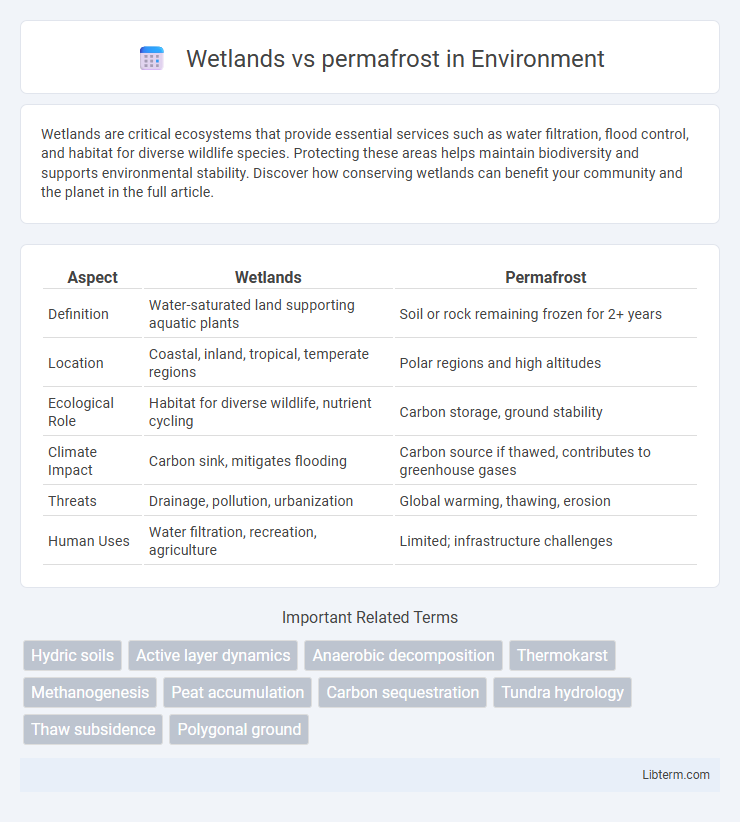Wetlands are critical ecosystems that provide essential services such as water filtration, flood control, and habitat for diverse wildlife species. Protecting these areas helps maintain biodiversity and supports environmental stability. Discover how conserving wetlands can benefit your community and the planet in the full article.
Table of Comparison
| Aspect | Wetlands | Permafrost |
|---|---|---|
| Definition | Water-saturated land supporting aquatic plants | Soil or rock remaining frozen for 2+ years |
| Location | Coastal, inland, tropical, temperate regions | Polar regions and high altitudes |
| Ecological Role | Habitat for diverse wildlife, nutrient cycling | Carbon storage, ground stability |
| Climate Impact | Carbon sink, mitigates flooding | Carbon source if thawed, contributes to greenhouse gases |
| Threats | Drainage, pollution, urbanization | Global warming, thawing, erosion |
| Human Uses | Water filtration, recreation, agriculture | Limited; infrastructure challenges |
Introduction to Wetlands and Permafrost
Wetlands are ecosystems saturated with water, supporting diverse plant and animal species while playing a crucial role in carbon sequestration and water filtration. Permafrost refers to permanently frozen ground found in polar and subpolar regions, significantly influencing global climate patterns by storing vast amounts of organic carbon. Understanding the dynamics of wetlands and permafrost is essential for assessing their impacts on climate regulation and ecosystem resilience.
Defining Wetlands: Key Features and Types
Wetlands are ecosystems characterized by saturated soil conditions and the presence of water-loving vegetation, playing a critical role in carbon storage and biodiversity support. Major types include marshes, swamps, bogs, and fens, each differing in water source, soil composition, and dominant plant species. Unlike permafrost environments, which are defined by permanently frozen ground, wetlands maintain dynamic hydrological cycles essential for nutrient cycling and habitat provision.
Understanding Permafrost: Formation and Characteristics
Permafrost forms when soil, rock, or sediment remains at or below 0degC for at least two consecutive years, creating a permanently frozen ground layer predominantly found in polar and subpolar regions. Unlike wetlands, which are characterized by saturated soil and abundant surface water supporting diverse ecosystems, permafrost impacts hydrology by restricting water infiltration and influencing surface water distribution. Its unique physical and thermal properties control carbon storage, greenhouse gas emissions, and landscape stability, making it critical to climate change studies.
Global Distribution: Where Wetlands and Permafrost Occur
Wetlands are predominantly found in low-lying areas with abundant water sources, including tropical regions like the Amazon Basin, temperate zones such as the Mississippi River Delta, and boreal regions of Canada and Russia. Permafrost primarily exists in high-latitude regions including Siberia, Alaska, Northern Canada, and parts of Greenland, characterized by continuously frozen ground for two or more consecutive years. The global distribution of wetlands overlaps with permafrost zones mainly in Arctic and subarctic regions, where thawing permafrost influences wetland formation and hydrology.
Ecological Roles of Wetlands vs Permafrost
Wetlands serve as critical carbon sinks by storing organic material and regulating water cycles, while permafrost preserves ancient carbon deposits that, when thawed, release greenhouse gases like methane and carbon dioxide. Wetlands support biodiversity by providing habitats for numerous species, whereas permafrost maintains soil stability and influences global climate regulation through its frozen ground. Both ecosystems play vital roles in climate dynamics, carbon sequestration, and sustaining ecological balance.
Carbon Storage: Climate Impact of Wetlands and Permafrost
Wetlands store approximately 20-30% of the world's soil carbon despite covering only about 6-9% of the Earth's surface, acting as significant carbon sinks due to slow decomposition in water-saturated soils. Permafrost regions hold nearly twice the amount of carbon found in the atmosphere, with estimated 1,400 to 1,600 gigatons of organic carbon locked in frozen layers, vulnerable to release as temperatures rise. The thawing of permafrost accelerates greenhouse gas emissions, while wetland degradation disrupts carbon sequestration balances, both critically influencing global climate change trajectories.
Biodiversity in Wetlands vs Permafrost Regions
Wetlands host rich biodiversity, supporting diverse species such as amphibians, migratory birds, and aquatic plants adapted to saturated soils and fluctuating water levels. In contrast, permafrost regions exhibit limited biodiversity due to extreme cold, slow nutrient cycling, and seasonal thawing, favoring specialized microorganisms, lichens, and hardy tundra vegetation. The high productivity of wetlands contrasts with the fragile, slow-growing ecosystems of permafrost areas, emphasizing the critical role of hydrology and temperature in shaping regional biodiversity.
Human Activities and Threats to Wetlands and Permafrost
Human activities such as agriculture, urban development, and fossil fuel extraction accelerate the degradation of wetlands and permafrost, causing habitat loss and increased greenhouse gas emissions. Wetland drainage for farming disrupts ecological balance, while permafrost thaw triggered by infrastructure construction releases methane, a potent greenhouse gas. These combined impacts threaten biodiversity, carbon storage capacity, and climate stability in affected regions.
Climate Change Effects on Wetlands and Permafrost
Climate change accelerates the thawing of permafrost, releasing stored greenhouse gases like methane and carbon dioxide, which intensify global warming. Wetlands, sensitive to temperature and hydrological shifts, experience altered water levels and vegetation changes, affecting biodiversity and carbon sequestration capacity. These transformations in wetlands and permafrost create feedback loops that exacerbate climate change impacts and disrupt ecosystems.
Conservation Strategies: Preserving Wetlands and Permafrost
Conservation strategies for wetlands emphasize water management, habitat restoration, and pollution control to maintain biodiversity and ecosystem services. Permafrost preservation focuses on mitigating climate change effects through reduced greenhouse gas emissions and implementing monitoring systems to track thaw progression. Both approaches require integrating scientific research with policy frameworks to sustain these vital environments amid global environmental changes.
Wetlands Infographic

 libterm.com
libterm.com